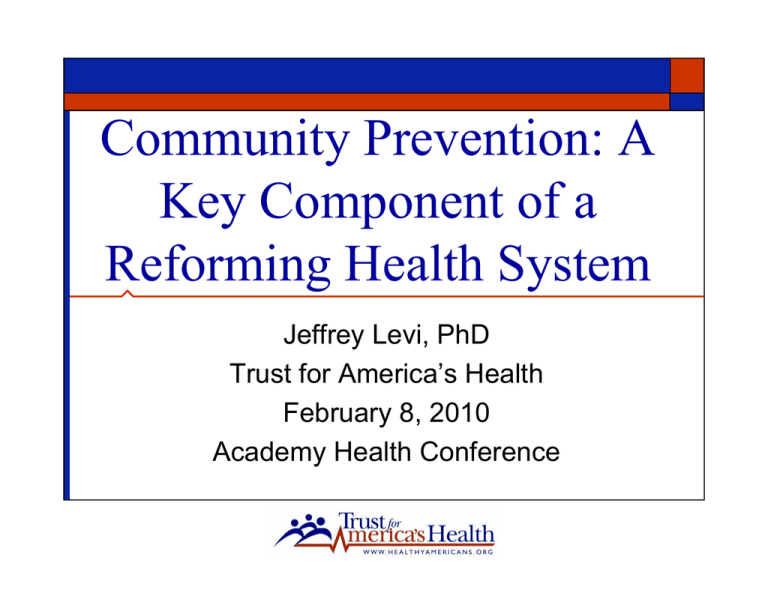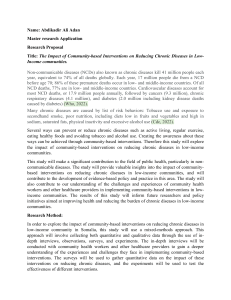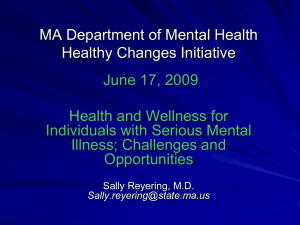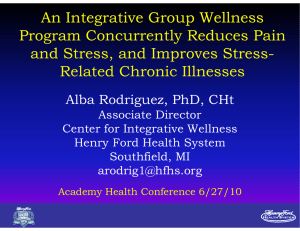Community Prevention: A Key Component of a Reforming Health System Jeffrey Levi, PhD
advertisement

Community Prevention: A Key Component of a Reforming Health System Jeffrey Levi, PhD Trust for America’s Health February 8, 2010 Academy Health Conference What is Community-Level Prevention? Interventions that promote healthy environments and behaviors – making it easier for people to make healthy choices, such as: Changing community norms and empowering communities Coalition and social network building Social marketing campaigns Changing the physical and social environments Organizational practices and governmental policies Facilities and programs Walkability – lighting, sidewalks, signs; Access to healthy foods Increasing individual knowledge and skills Examples of community programs Shape Up Somerville Healthy Eating Active Communities (HEAC) Schools, after school, neighborhoods, healthcare sector, marketing changes YMCA Pioneering Healthier Communities School food, school activities, parent and community outreach, restaurants, safe routes to school Community coalitions, policy changes, leverage other funding Healthier Communities, Steps, REACH American Recovery & Reinvestment Act $650 million in stimulus bill to “carry out evidence-based clinical and community-based prevention and wellness strategies…that deliver specific, measurable health outcomes that address chronic disease rates.” Grants targeting smoking, physical activity, nutrition and obesity – emphasis on structure and policy change “a historic commitment to wellness initiatives will keep millions of Americans from setting foot in the doctor's office in the first place -- because these are preventable diseases and we're going to invest in prevention.” – President Barack Obama, Feb. 17, 2009 The new “conventional wisdom” “Prevention encompasses health promotion activities that encourage healthy living and limit the initial onset of chronic diseases. These activities include behavioral strategies as well as policy or environmental strategies to improve health outcomes. Widespread use of effective, population-based approaches to increase physical activity and consumption of fruits and vegetables reduce obesity and tobacco use, and promote recommended screenings can reduce the incidence of various associated chronic conditions, prevent some disabilities and reduce the severity of others.” CDC Congressional Justification, FY 2011 Budget NOT limited to chronic conditions Health reform: Real money for prevention (mandatory appropriation) Senate Prevention and Public Health Investment Fund: $15 billion over 10 years (permanent authorization at $2 billion a year) House Prevention and Wellness Trust: $15.4 billion over 5 years Supports new and existing prevention and public health programs, including Community Transformation Grants Separate fund for Community Health Centers (5 years) Community Prevention rises to $1.6 billion in 2014 Core public health rises to $1.265 billion in 2014 Research rises to $300 million in 2014 Both bills also support investment in US Preventive Services Task Force and Community Guide True community-based prevention Senate Community Transformation Grants Requires detailed plan for policy, environmental, programmatic and infrastructure changes to promote healthy living and reduce disparities Create healthier school environments, including healthy food options, physical activity opportunities, promotion of healthy lifestyles Develop and promote programs targeting increased access to nutrition, physical activity, smoking cessation and safety Highlight healthy options at restaurants and food venues Community prevention (2) House Community-Based Prevention and Wellness Services Evidence-based community prevention and wellness services in priority areas identified by the Secretary in the national prevention strategy Health Empowerment Zones – targeting interventions where multiple issues are at stake How did prevention become so important? Framed in the context of chronic diseases Chronic care costs are the drivers of increases in premiums (and costs to the public programs) Most are driven by smoking and obesity – and these require non-clinical interventions Where do infectious diseases fit in? Place-based strategies need to think across traditional disease groupings If comprehensive health reform stalls? Stand alone legislation Reassess existing programs to fit this new vision of the focus of publicly funded prevention activities See Major Cities Initiative in the President’s Budget Train public health officials to use “soft power” to bring about policy and environmental change




![[subject line] You're invited to share the health](http://s3.studylib.net/store/data/008613453_1-c65c31d0738aa28772fa551d6f3e1bcf-300x300.png)



